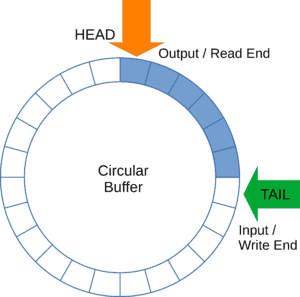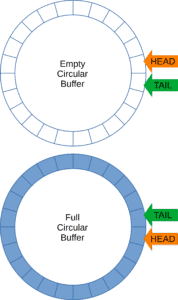1. 简介
在本篇文章中,我们将深入理解环形缓冲区(Circular Buffer)这一经典的数据结构。它在工程和计算机科学中被广泛应用,特别是在实时系统、嵌入式开发和数据流处理中表现尤为突出。
我们会从基本概念出发,逐步分析其内部结构、优缺点,并与其它缓冲结构进行对比,帮助你更全面地掌握这一实用工具。
2. 环形缓冲区的概念
环形缓冲区是一种定长数组,用于以循环方式存储数据。它也被称为“环形队列”或“循环缓冲区”,其核心特点是数据按先进先出(FIFO)的方式读取。
2.1 工程领域中的应用
在非计算机领域,比如制造业和流水线系统中,环形缓冲区可用于临时存储传送带上的物品,实现有序处理。例如,在“准时制生产”(JIT)系统中,环形缓冲区用于管理原材料的流入与加工顺序。
2.2 计算机科学中的应用
在编程中,环形缓冲区常用于以下场景:
- 实时数据采集与处理(如传感器数据)
- 音视频流缓冲
- 网络通信协议中的数据包暂存
- 嵌入式系统中的串口通信
其核心机制是:使用两个指针(head 和 tail)分别指向写入位置和读取位置。当 head 追上 tail 时,表示缓冲区已满;当 tail 追上 head 时,表示缓冲区为空。
✅ 优势:插入和删除操作的时间复杂度为 O(1),效率高
❌ 缺点:容量固定,数据可能被覆盖

3. 环形缓冲区的数据结构
3.1 结构组成
环形缓冲区本质上是一个循环数组,其结构由以下元素组成:
- 一个固定长度的数组
buffer[] - 指针
head:指向下一个要写入的位置 - 指针
tail:指向最早写入的数据位置
当 head 和 tail 指向同一位置时,表示缓冲区为空。当 head 移动到数组末尾后,会“绕回”数组开头,形成一个“环”。

3.2 实现方式示例(Java)
下面是一个简单的 Java 实现:
public class CircularBuffer {
private final int[] buffer;
private int head = 0; // 下一个写入位置
private int tail = 0; // 最早写入的数据位置
private int count = 0; // 当前数据个数
public CircularBuffer(int size) {
buffer = new int[size];
}
public void write(int value) {
buffer[head] = value;
head = (head + 1) % buffer.length;
if (count < buffer.length) {
count++;
} else {
tail = (tail + 1) % buffer.length; // 覆盖旧数据
}
}
public int read() {
if (count == 0) throw new IllegalStateException("Buffer is empty");
int value = buffer[tail];
tail = (tail + 1) % buffer.length;
count--;
return value;
}
public boolean isEmpty() {
return count == 0;
}
public boolean isFull() {
return count == buffer.length;
}
}
⚠️ 注意:该实现未考虑多线程安全问题,实际生产环境中需加锁或使用线程安全结构。
4. 环形缓冲区的应用场景
4.1 数据流处理
环形缓冲区广泛用于音视频流的缓冲处理。例如:
- 音频播放器中缓存音频帧
- 视频解码器中缓存图像帧
- 实时监控系统中缓存传感器数据
4.2 通信协议
在底层通信协议中,例如:
- 串口通信(如 RS232)
- 网络数据包缓存
- 嵌入式系统中断处理
环形缓冲区可以高效地处理异步数据输入输出,避免频繁的内存分配和释放。
5. 性能分析与对比
5.1 优点
- ✅ 插入、删除操作时间复杂度为 O(1)
- ✅ 内存利用率高,无需频繁扩容
- ✅ 适合实时系统和嵌入式场景
- ✅ 减少内存碎片(相比链表)
5.2 缺点
- ❌ 容量固定,数据可能被覆盖(若未及时处理)
- ❌ 判断空/满状态较复杂(需额外变量或预留空间)
- ❌ 多线程环境下实现较复杂(需同步机制)
5.3 与其他缓冲结构对比
| 类型 | 特点 | 适用场景 |
|---|---|---|
| 线性缓冲(数组) | 简单易实现,可扩容 | 通用场景 |
| 链表缓冲 | 动态扩容,内存开销大 | 不固定长度数据 |
| 栈缓冲(LIFO) | 后进先出,逻辑简单 | 单线程场景 |
| 环形缓冲 | 固定容量,FIFO,高效 | 实时、嵌入式、流处理 |
6. 总结
环形缓冲区是一种高效的缓冲结构,特别适合数据需要按 FIFO 顺序处理的场景。其核心优势在于:
- 时间复杂度低(O(1))
- 内存使用紧凑
- 适合嵌入式和实时系统
但它也有局限性,比如容量固定、空/满判断复杂、多线程下需同步等。
✅ 适用场景:音视频流处理、嵌入式通信、实时数据采集
❌ 不适用场景:数据量波动大、对数据完整性要求极高
如果你在开发一个嵌入式设备、网络协议栈、或者实时音频处理系统,环形缓冲区将是一个非常值得考虑的结构。